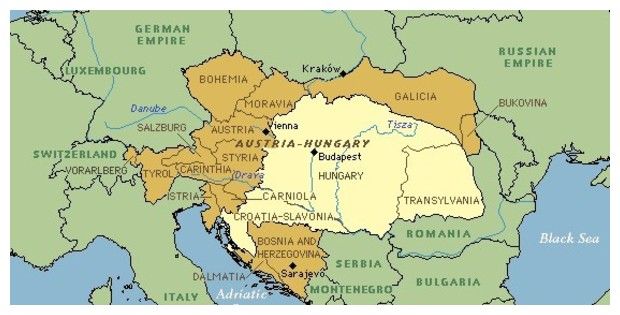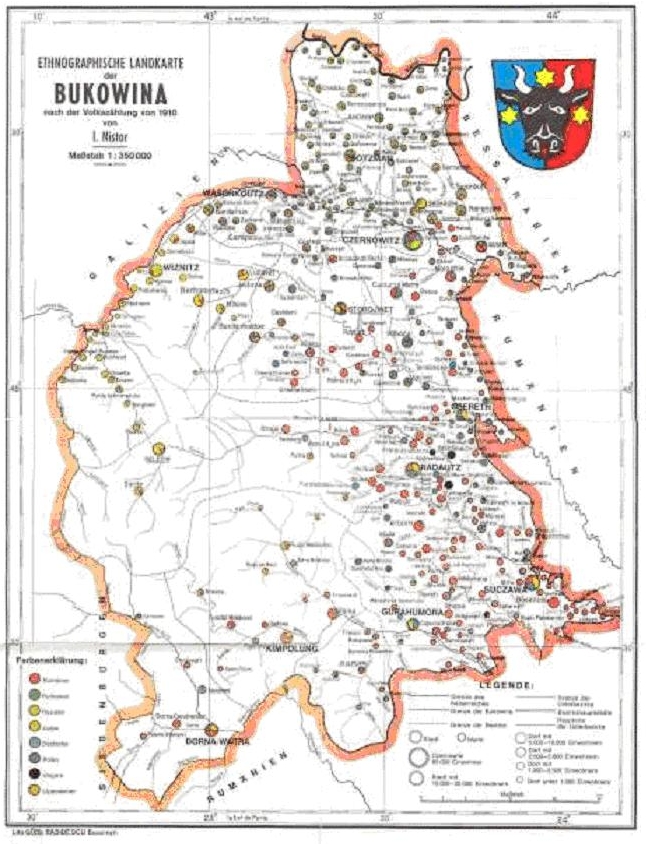
The Germans from the BukovinaDefinitionThe Bukovina was a region in southeastern Europe, located on the eastern slopes of the Carpathian Mountains. It belonged to the Ottoman Empire until 1775 when it was annexed by Austria, and was then administered together with Galicia until 1850 when it became a crown land in the Austrian monarchy. In 1915, the Bukovina was occupied by Russia, and until its partition in 1944 it changed hands several times between the Soviet Union and Rumania. Since then, the northern part has belonged to Ukraine and the southern part to Rumania.  Source: http://freepages.genealogy.rootsweb.ancestry.com/~menzak/maps/map-ah.jpg SettlementBetween the 14th and the 17th century, a small group of German craftsmen and merchants lived in the area and represented an important economic factor. However, they disappeared as a consequence of war, disease, and gradual assimilation in the 17th century. After the Bukovina became part of Austria in 1775, German craftsmen and farmers from Upper Hungary, the Banat, Galicia, the Palatinate, Baden and Hesse migrated to the area. By 1786 much of the available land was occupied, and therefore daughter colonies were founded in Galicia, Bessarabia, and the Dobrudja. The Austrian administration pursued a policy of populating the region. Immigration was encouraged; Joseph II.'s various patents granting religious toleration, in this aspect, attracted also non-Catholic settlers. The northern Bukovina got a Ruthenian (Ukrainian) population majority, the southern Bukovina a Moldavian (Romanian) population. Significant numbers of German settlers, both Catholics and Protestants, came into the country; in the late 19th century Germans would form about eight of the population. The administration would continue to encourage immigration up to World War I. While many of the immigrants were farmers, some of the German immigrants were miners; a mining industry emerged on the slopes of the Carpathian mountains. [1] 
Source: http://www.bukovinasociety.org/map1910m.html During the 19th century, the German-speaking middle class belonged to the political and intellectual elite, and the German language soon predominated as the language of administration, education, and jurisdiction. In 1910, the Bukovina had a population of about 800,000 of whom 41% were Ruthenians, 31% Rumanians, eight percent were of German origin, and four percent were Poles. Almost 22% of the Bukovinians had German as their mother tongue, and from 1875 on its capital Czernowitz had a German-language university. After the dissolution of the Austro-Hungarian monarchy, the Bukovina—against the wishes of most of its population—became a part of Rumania. German schools and cultural institutions schools were Romanised. Many German Bukovinians emigrated between 1918 and 1948 while some of those remaining sympathized with the German Reich as a consequence of their suppression by the Rumanian government, poor economic conditions, and strong Nazi propaganda. In 1939/1940 the Reich resettled about 100,000 persons to the Warthe-Gau and eastern Upper Silesia. It has been estimated that only around 7,500 German Bukovinians still lived in their homeland after the War. Virtually all emigrated to Germany by 1992. [2] Settlement in the U.S. and Western CanadaAs the population of Bukovina expanded, so did the pressures for emigration. Farmers with large families could no longer divide their homesteads among their children, and industry in Bukovina had never grown to the extent in had elsewhere in the Austrian Empire, or in the New World. The first wave of Bukovina German emigration began in the 1880's. Most of these emigrants would settle in communities among their Landsleute. These destinations included Ellis (Kansas), Yuma County (Colorado), Naperville (Illinois), Lewis County (Washington) as well as Saskatchewan and Rio Negro (Brazil). A second wave of emigration to the Americas took place in the years preceding and following World War I. [3] From Bukovina, the emigration of German farmers to Canada was relatively large after 1890 and was directed predominantly to western Canada, especially to Saskatchewan. They began to arrive in Edenwold and vicinity, as well as in Vibank, in 1890, and in Mariahilf-Grayson, Kennell-Craven, Markinch, Claybank, Spring Valley and Silton in 1900. Most of them were Protestants; the Catholic minority settled in the Mariahilf colony near Grayson. The Bukovinian immigrants came mostly from the area between Czernowitz and Suczawa, in particular from Fratauz, Satulmare, Badeutz, St. Onufry, Arbora, Tereblestie, Ilischestie, Itzkany, Radautz, Rosch, Molodia, Derelui, Cuszur Mare, and from Czernowitz and Suczawa. [4] Notes[1] "History of the Bukovina," http://www.zum.de/whkmla/region/balkans/bukovina17751815.html. Accessed on March 7, 2004. [2] "Die Deutschen und ihre östlichen Nachbarn," http://www.oestlichenachbarn.bayern.de/. Accessed on March 7, 2004. [3] "The Bukovina Society of the Americas," http://www.bukovinasociety.org/#A%20Short%20History %20of%20Bukovina. [4] Lehmann, Heinz, The German Canadians: 1750-1937. Immigration, settlement and culture. Translated, edited and introduced by Gerhard P. Bassler (St. John's, NF: Jesperson Presss, 1986), p. 121. Sources1. "History of the Bukovina from the earliest times on (in German)," http://www.bukowina.info/Gesch-1.html. Accessed on April 19, 2004. 2. "History of the Bukovinian Germans. Geographical overview (in German)," http://www.bukowina.info/Geo-1.html. Accessed on April 19, 2004. 3. The Bukovina Society of the Americas, http://www.bukovinasociety.org/ |
